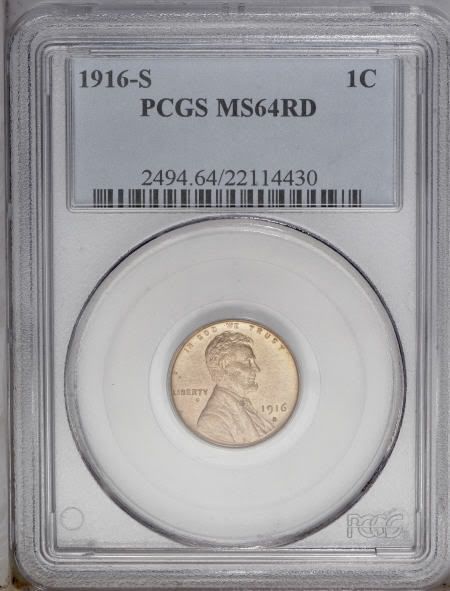Options
What would you pay to have this 16-s Lincoln in your set?
 DMWJR
Posts: 6,039 ✭✭✭✭✭
DMWJR
Posts: 6,039 ✭✭✭✭✭
It sold March 1, 2006 for $1,955. I passed on it Would you pay more or less if it were on the market in 07? (stay with me on this one, it has a twist at the end)



Doug
0
Comments
Bob
p.s. Hard to see it clearly with all the glare. Ever heard of photoshop?
it looks dipped.The color is too bright.
it was resubmitted and came back in a body bag ?
stewart
One 1916-s MS64 Lincoln purchased on March 1, 2006 - $1,955
Grading fees - $100
Getting it in an MS65 holder and auctioned back off less than one year later on February 14, 2007 - $11,500.00
The power of the plastic? PRICELESS!
Link to Feb 14, 2007 sale
coin
same coin
<< <i>You guys remember this 12-d, correct?
coin
same coin >>
The power of plastic? You can say that again!
Lincoln set Colorless Set
In honor of the memory of Cpl. Michael E. Thompson
In the SF Bay Area a house is sold for x in 2004, the buyer trims the grass, puts in new landscaping, paints the outside and inside and stages the home with furniture and other household items. 6 months later it is resold for 50% over what is sold for 6 months before and the new buyer takes out 100% financing no doc
o income verification ARM loan to buy the home.
1 year later the buyer, after the teaser rate expires, stops making payments and the lender forecloses. The market in less stable areas (where the home is located) tanks. The lender takes title to the property at foreclosure and has a REO.
The REO Manager looks at the property, sees it needs cosmetic work, has the work performed and puts the property on the market for $50K over the unpaid balance of the loan on the banks books. The property does not sell. In fact, hundreds of similar, if not identical homes, are on the market at the same time. Homes are not selling at list prices. Inventory backs up. Buyers want the homes but they can not qualify for a purchase money loan of more than half the list price since the lending industry has changed its lending practices and decided that borrowers must actually prove they have a job with enough income to allow them to actually make the loan payments. The banks can not believe that the property is not worth what the loan balance is on the books. The bank finally decides to sell the home for whatever it can get and charge off the loss. The home sells for 40% - 50% of what the bank has invested in the property and charges off the loss.
The new buyer gets a new home at half of what it sold for one year ago. The assessed value of the property for county tax purposes goes down. The property tax revenue to the county plummets. Stories about doomsday in the housing market are splashed across the headlines.
However, the new buyer has a great deal on the house. After the bad loans get foreclosed and the losses are charged off by the banks, the banks decide that their income from new real estate loans is substandard. Managers decide that there lending requirements need to be loosened to generate more income from points and fees. Loans become easier to obtain. More buyers can get loans, demand for housing goes up. Prices increase. One year after the buyer purchases the home for half of what it sold for one year earlier, the price has gone up 30%. The new buyer thinks real estate riches are his and that he is brilliant in buying the home.
And the saga continues. All the while, the home stays the same, except at times it looks great and shows well and at other times it looks neglected and has deferred maintenance.
Same things with coins. The window dressing (the grade on the slab assigned by the grading expert for a fee) goes a long way to determining the sale price of the coin (er, house). Funny how things work and funny how human nature (one's desires, wants and needs) manifests itself in the same coin being sold for hundreds of dollars one day and months later being sold for five figures.
The color/exposure of Heritage copper images through the years can't be understood, only watched in amazement.
No doubt the same coins, and nothing has been done to them. Only the image, and grade, have drastically changed.
This is a very informative post about two of the major coin industries of our time. PCGS and Heritage.
Nice post DMWJR